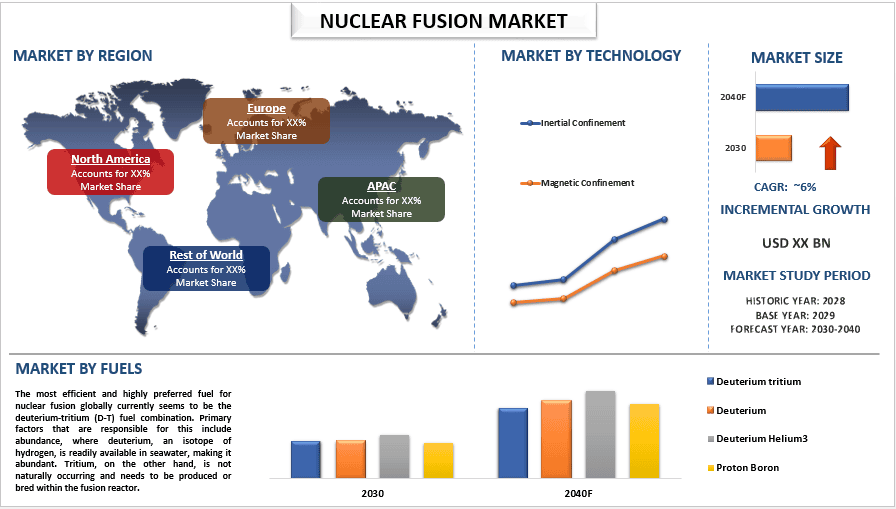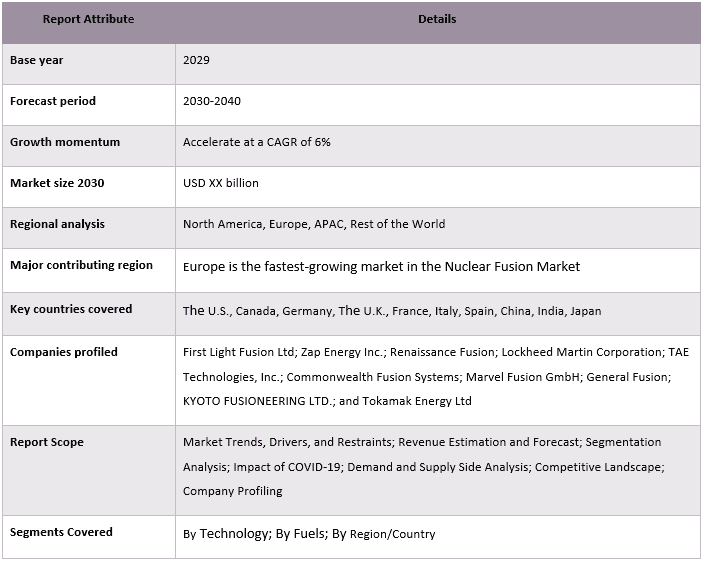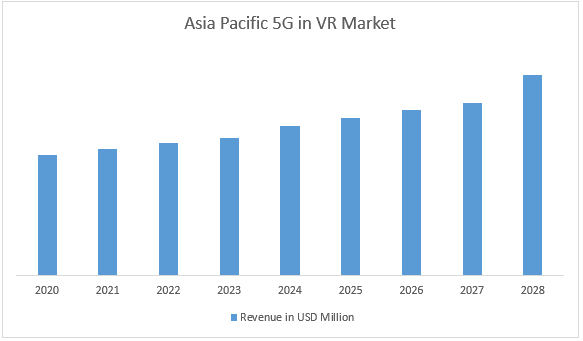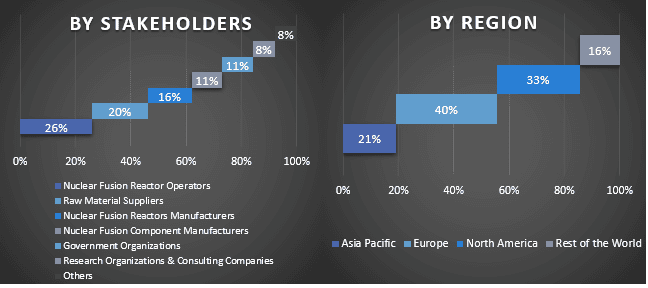Emphasis on Technology (Inertial Confinement and Magnetic Confinement), Fuels (Deuterium-Tritium, Deuterium, Deuterium Helium3, and Proton Boron); and Region/Country

The Nuclear Fusion Market was valued at XX billion in the year 2030 and is expected to grow at a steady rate of around 6% during the forecast period (2030-2040), owing to the increased government funding for nuclear energy. Furthermore, the increasing need for sustainable energy sources and rising concerns over climate change and depleting fossil fuel reserves have catapulted nuclear fusion into the mainstream due to its potential to provide an emission-free, virtually limitless energy supply, addressing global energy demands. Moreover, advancements in technology have significantly enhanced the feasibility and commercial viability of nuclear fusion. Innovations in plasma confinement, superconducting magnets, and fusion reactor designs have led to the development of more efficient and compact fusion reactors. These technological advancements have bolstered investor confidence and attracted substantial funding to the sector. For instance, in December 2022, a significant scientific advancement in nuclear fusion science was announced by the U.S. Department of Energy. Remarkably, the fusion reaction yielded more energy than the amount required to initiate it, marking a groundbreaking achievement.
Some of the major players operating in the market include First Light Fusion Ltd; Zap Energy Inc.; Renaissance Fusion; Lockheed Martin Corporation; TAE Technologies, Inc.; Commonwealth Fusion Systems; Marvel Fusion GmbH; General Fusion; KYOTO FUSIONEERING LTD.; and Tokamak Energy Ltd. Several M&As along with partnerships have been undertaken by these players to facilitate customers with hi-tech and innovative products/technologies.
Insights Presented in the Report
“Amongst Technology Type, the Magnetic Confinement Segment Held Majority of the Market Share in the Year 2030.”
Based on technology, the market is bifurcated into inertial confinement and magnetic confinement. Magnetic confinement is generally considered the most efficient and highly preferred technology for global nuclear fusion. The primary factor responsible for this inclination towards magnetic confinement is that they allow for sustained plasma confinement over longer durations, which is essential for achieving the conditions required for nuclear fusion. While inertial confinement typically involves short-duration pulses that are more suitable for other applications, such as laser fusion. Furthermore, magnetic confinement technologies, such as tokamaks and stellarators, are more scalable and can be developed into larger and more powerful devices. This scalability enables the production of more significant amounts of fusion energy in the long run. In addition to this, the magnetic confinement approach provides better control over the shape and stability of the plasma, allowing for more efficient reactor designs. This enhances the ability to control fusion reactions and maximize energy output.
Amongst Fuels, the Deuterium-Tritium holds the Majority Share of the Market
Based on fuels, the market is segmented into deuterium-tritium, deuterium, deuterium helium3, and proton boron. The most efficient and highly preferred fuel for nuclear fusion globally currently seems to be the deuterium-tritium (D-T) fuel combination. Primary factors that are responsible for this include abundance, where deuterium, an isotope of hydrogen, is readily available in seawater, making it abundant. Tritium, on the other hand, is not naturally occurring and needs to be produced or bred within the fusion reactor. However, tritium can be bred from lithium, which is also relatively abundant. Furthermore, D-T fusion has the lowest temperature requirements for achieving fusion, making it relatively easier to achieve and sustain compared to other fuel combinations. In addition to this, D-T fusion offers the highest energy output per unit mass compared to other fuel combinations. This higher energy output contributes to its preference as a fuel for commercial fusion power generation.
“Europe is anticipated to be one of the Fastest Growing Market for Nuclear Fusions across the Globe during the Forecast Period (2030-2040).”
Europe has made remarkable strides and is widely recognized as a frontrunner in the realm of nuclear fusion power generation. Numerous factors have contributed to Europe’s progress in this domain, with one notable example being the International Thermonuclear Experimental Reactor (ITER). As the host of the ITER project, Europe boasts the world’s largest experimental fusion facility, situated in France. This collaborative endeavor involves 35 countries, including several European nations, and has significantly bolstered Europe’s position as a leader in nuclear fusion research. Moreover, Europe has fostered robust partnerships among research institutions and universities dedicated to advancing fusion energy. The European Fusion Development Agreement (EFDA) and the EUROfusion consortium are prime illustrations of such collaborations, uniting scientists, engineers, and resources for the advancement of fusion energy. Additionally, Europe’s research infrastructure for nuclear fusion is firmly established, with facilities like the Joint European Torus (JET) in the United Kingdom and the Wendelstein 7-X facility in Germany playing pivotal roles in Europe’s leadership in fusion research.
Nuclear Fusion Market Report Coverage

Reasons to buy this report:
Customization Options:
The global nuclear fusion market can further be customized as per the requirement or any other market segment. Besides this, UMI understands that you may have your own business needs, hence feel free to contact us to get a report that completely suits your requirements.
1. Market Introduction
2. Research Methodology Or Assumption
3. Market Synopsis
4. Executive Summary
5. Impact Of Covid-19 On The Nuclear Fusion Market
6. Nuclear Fusion Market Revenue (usd Bn), 2020-2030f.
7. Market Insights By Technology
8. Market Insights By Fuels
9. Market Insights By Region
10. Nuclear Fusion Market Dynamics
11. Nuclear Fusion Market Opportunities
12. Nuclear Fusion Market Trends
13. Demand And Supply-side Analysis
14. Value Chain Analysis
15. Competitive Scenario
16. Company Profiled
17. Disclaimer
Analyzing the historical market, estimating the current market, and forecasting the future market of the global nuclear fusion market were the three major steps undertaken to create and analyze the adoption of nuclear fusion in major regions globally. Exhaustive secondary research was conducted to collect the historical market numbers and estimate the current market size. Secondly, to validate these insights, numerous findings and assumptions were taken into consideration. Moreover, exhaustive primary interviews were also conducted, with industry experts across the value chain of the global nuclear fusion market. Post assumption and validation of market numbers through primary interviews, we employed a top-down/bottom-up approach to forecasting the complete market size. Thereafter, market breakdown and data triangulation methods were adopted to estimate and analyze the market size of segments and sub-segments of the industry pertains to. Detailed methodology is explained below:
Step 1: In-Depth Study of Secondary Sources:
A detailed secondary study was conducted to obtain the historical market size of the nuclear fusion market through company internal sources such as annual reports & financial statements, performance presentations, press releases, etc., and external sources including journals, news & articles, government publications, competitor publications, sector reports, third-party database, and other credible publications.
Step 2: Market Segmentation:
After obtaining the historical market size of the nuclear fusion market, we conducted a detailed secondary analysis to gather historical market insights and share for different segments & sub-segments for major regions. Major segments, such as technology and fuels, are included in the report. Further country-level analyses were conducted to evaluate the overall adoption of testing models in that region.
Step 3: Factor Analysis:
After acquiring the historical market size of different segments and sub-segments, we conducted a detailed factor analysis to estimate the current market size of the nuclear fusion market. Further, we conducted factor analysis using dependent and independent variables such as technology and fuel of the nuclear fusion market. A thorough analysis was conducted for demand and supply-side scenarios considering top partnerships, mergers and acquisitions, business expansion, and product launches in the nuclear fusion market sector across the globe.
Current Market Sizing: Based on actionable insights from the above 3 steps, we arrived at the current market size, key players in the global nuclear fusion market, and market shares of the segments. All the required percentage shares split, and market breakdowns were determined using the above-mentioned secondary approach and were verified through primary interviews.
Estimation & Forecasting: For market estimation and forecast, weights were assigned to different factors, including drivers & trends, restraints, and opportunities available for the stakeholders. After analyzing these factors, relevant forecasting techniques, i.e., the top-down/bottom-up approach, were applied to arrive at the market forecast for 2030 for different segments and sub-segments across the major markets globally. The research methodology adopted to estimate the market size encompasses:
Primary Research: In-depth interviews were conducted with the Key Opinion Leaders (KOLs), including Top Level Executives (CXO/VPs, Sales Head, Marketing Head, Operational Head, Regional Head, Country Head, etc.) across major regions. Primary research findings were then summarized, and statistical analysis was performed to prove the stated hypothesis. Inputs from primary research were consolidated with secondary findings, hence turning information into actionable insights.

Market Engineering
The data triangulation technique was employed to complete the overall market estimation and to arrive at precise statistical numbers for each segment and sub-segment of the global nuclear fusion market. Data was split into several segments & sub-segments after studying various parameters and trends in the areas of technology and fuel in the global nuclear fusion market.
The current & future market trends of the global nuclear fusion market were pinpointed in the study. Investors can gain strategic insights to base their discretion for investments on the qualitative and quantitative analysis performed in the study. Current and future market trends determined the overall attractiveness of the market at a regional level, providing a platform for the industrial participant to exploit the untapped market to benefit from a first-mover advantage. Other quantitative goals of the studies include:

Q1: What is the current market size and growth potential of the global Nuclear Fusion Market?
Q2: What are the driving factors for the growth of the global Nuclear Fusion Market?
Q3: Which segment has the largest share of the global Nuclear Fusion Market by Technology?
Q4: What are the emerging technologies and trends in the global Nuclear Fusion Market?
Q5: Which region will dominate the global Nuclear Fusion Market?
Q6: Who are the key players operating in the global Nuclear Fusion Market?
Customers who bought this item also bought